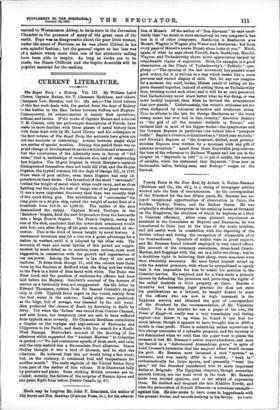CURRENT LITERAT IJRE.
The Royal Navy : a History. Vol. H. By William Laird Clowes, Captain Mahan, Sir T. Clements Markham, and others. (Sampson Low, Marston, and Co. 25s. net.)—The third volume of this fine work deals with the period from the days of Rodney to the battles in the East Indies between Suffren and Hughes. Consequently, its subject-matter is mainly fleet operations, actions, and tactics. If the works of Captain Mahan and Admiral P. H. Colomb, with the picturesque descriptions of Froude, have made us more familiar with these phases of naval history than with those dealt with by Mr. Laird Clowes and his colleagues in the first volume of The Royal Navy, the accounts here given are not less accurate or interesting. Actions between single ships are matter of special mention. During this period there was no great change or development in naval construction and armament ; but the conclusions of the Admiralty were in favour of "3rd rates," that is, battleships of moderate size, aud of constructing fast frigates. The 32-gun frigates in which Marryat's captains distinguished themselves were not built till 1748, and the 36-gu.n frigates, the typical cruisers, till the days of George III., in 1757. Guns were of poor calibre ; even these frigates had only 12. pounders on their decks. The invention of the short " carronade" trebled the weight of metal which ships could carry, and as close fighting was the rule, the loss of range was of no great moment. It was a more important discovery then than was recently that of the quick-firing gun. The substitution of " carronades" for long guns on a 44-gun ship raised the weight of metal fired at a broadside from 31.8 lb. to 1,238 lb. The calibre of the shot demoralised the enemy. Captain Henry Trollope, in the 'Rainbow' frigate, fired the new 32-pounders from the forecastle into a large French frigate. The French Captain, seeing the size of the shot, concluded that the lower-deck armament would sink him, end, after firing off his guns once, surrendered at dis- cretion. This is the kind of lesson taught by naval history. A mechanical invention may fore time win a great advantage for a nation in warfare, until it is adopted by the other side. The accounts of wars and naval battles of this period are supple. merited by much detail as to matters, some curious, some most suggestive, in connection with the growth and organisation of our sea-power. Among the former is the story of our naval uniform. It dates from George II., and the colours were those worn by the Duchess of Bedford when the King met her riding in the Park in a habit of blue faced with white. The Duke was First Lord, and the question of uniforms for officers had been laid before his Majesty. Suaollett's account of the horrors of service on a battleship were not exaggerated. See the letter by Edward Thompson, written from Sir Samuel Cornish's 84-gun ship in 1756. Typhoid fever raged on the vessel, mainly from the foul water in the cisterns. Leaky ships were preferred, as the bilge, full of sewage, was cleansed by the salt water. Men preferred the chance of death by drowning to death by lever. Yet when the 'Sultan' was raised from Comino Channel, and sent home, her temporary crew are said to have Buffered from typhoid most severely. Sir Clements Markham contributes a chapter on the voyages and explorations of Shelvocke and Clipperton to the Pacific, and deals with the search for a North- West Passage. Shelvocke's account of the shooting of the albatross which suggested the "Ancient Mariner" to Coleridge is quoted We had continuous squalls of sleet, snow, and rain, and the only seabird was a disconsolate black albatross. Simon Hutley thought it was a bird of ill-omen, and he shot the albatross. He believed that this act would bring a fair wind ; but, on the contrary, it continued foul and tempestuous for another month." The early exploits of the United States Navy form part of the matter of this volume. It is illustrated fully by portraits and plans. Some striking British reverses are in- cluded; notably, the failure of the surprise of Buenos Ayres and the panic flight from before Puerto Cabello (p. 87).


















































 Previous page
Previous page